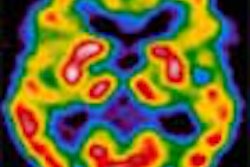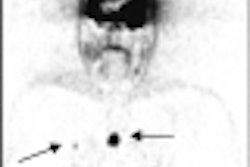Last week the U.S. Centers for Medicare and Medicaid Services (CMS) cut the ambulatory payment classification (APC) for FDG-PET from $2,331.18 to $1,375. The decision was disappointing, but it could have been worse, PET advocates say.
Lobbying efforts by the Academy of Molecular Imaging, the Society of Nuclear Medicine, PET vendors, and other groups apparently paid off somewhat in modifying the $841.94 payment rate CMS had originally proposed. In its earlier review of claims data from 1999 to 2000, CMS determined that there were approximately 5,000 single claims for FDG-PET scans, with a median cost of about $900, according to comments published in the November 30 edition of the Federal Register. After receiving information and data during the comment period, however, CMS reversed course.
"These data suggest that our claims cost data may not have accurately captured the entire costs of the procedure, particularly the cost of the FDG," CMS wrote. "Based on our analysis, we believe that the cost of an FDG-PET scan is between $1,200 and $1,800, with a midpoint of $1,500."
As a result, CMS reassigned FDG-PET services to APC 0978, New Technology - Level IX ($1,250-$1,500), which results in a payment rate of $1,375, according to CMS.
A flawed analysis?
CMS representatives were unavailable to offer details on the rationale behind the new classification, which takes effect on January 1. PET advocates , however, took issue with what they said were a number of flaws in the CMS methodology, including the limited sample base, and a seemingly random decision on the final reimbursement rate.
There were far more than 5,000 Medicare claims for PET procedures in the sample period, according to Ruth Tesar, a board member of the Los Angeles-based Academy of Molecular Imaging. The sample was also not representative of the scope of PET studies performed, she said.
In addition to the sample flaws, the claims data used in the CMS database were of poor quality, said AMI board member Dr. R. Edward Coleman of Duke University Medical Center in Durham, NC.
"We were disappointed because the data they based this on is extremely weak," Coleman said. "It's amazing how badly hospitals do in supplying data to Medicare; the range of costs that hospitals were submitting was anywhere from $150 to $2,400."
While CMS told AMI and others that coincidence detection-based PET studies (not covered by Medicare for new indications) were not included in the database, it's almost impossible to determine the nature of the studies from the claims data, Tesar said.
CMS did raise the rate significantly over its initial proposal, but it did not offer a rationale for its selection of the final APC rate, Coleman said.
"It's not appropriate to select a number out of the air without any justification for it, which they wound up doing," Coleman said. "We suggested they go back to the original APC amount -- Level XII -- until they have good data to support the actual cost of PET."
Driving outpatient PET
Whether the reimbursement cut will stunt PET's growth is uncertain. Several industry sources believe that a PET operation performing five or six studies a day can still be profitable with the new rate, so prospective purchasers will undoubtedly seek to ensure that they can achieve that patient volume before taking the plunge with a system purchase.
The rate cut also doesn't apply to outpatient imaging centers, which have, along with mobile sites, contributed 70% of new PET scanner purchases in the last few years, according to industry sources. The APC cut will likely continue to drive the trend toward PET utilization in outpatient imaging centers, at least in the short term, said Tom Hook, general manager, PET, for GE Medical Systems of Waukesha, WI.
"There will be some offset in the hospital-based market, but that slack will be taken up in the nonhospital-based sector," Hook said. "You can't stop the procedural volume train; that's a freight train that's moving very aggressively right now, both hospital-based and nonhospital-based. Clearly imaging centers are for the time being insulated from this rate change, and will actually benefit slightly from volume pushed over to their environment for the higher reimbursement rate."
In addition, Medicare patients typically make up about 30% to 40% of a PET business. And private carriers usually pay more than the APC rates, Tesar said.
However, some PET advocates believe the new APC rate will engender economic difficulties for low-volume hospital-based PET operators. The average procedure volume in the past 12 months for a dedicated PET site is approximately 2 1/2 studies per day, according to Terry Douglass, president of PET manufacturer CTI of Knoxville, TN.
"If you take any cost model, [including] various scanner prices, various costs of FDG, and various operating costs, and 2 1/2 studies per day rate, the [cost] range is around $1,800 to $3,100 [per procedure], depending on the rest of the data," Douglass said.
PET operators just starting out will be particularly hard hit by the APC rate cut, owing to the hefty amount of depreciation and startup costs, Tesar said.
With fewer sites being able to justify PET with the new reimbursement rate, the proliferation of the technology outside of metropolitan areas may also suffer, said Barbara Franciose, president of Siemens Medical Solutions - Nuclear Medicine Group in Hoffman Estates, IL.
So far, the PET market doesn't appear to have been affected significantly by the reimbursement decision, or from previous uncertainty over the initial proposed rate cut. Several PET vendors contacted by AuntMinnie.com reported little impact on PET purchasing activity. In addition, interest in PET was very strong at last week's RSNA meeting.
The impact on mobile PET sales is difficult to ascertain. Some market watchers believe that sites generating little study volume will be unable to cost-justify mobile PET services after the rate drop. Others, such as mobile PET provider Alliance Imaging of Anaheim, CA, see the reimbursement cut as an even more compelling argument for shared PET services.
"Hospitals will have to be very careful before they purchase [a scanner] to make sure they really have enough volume to justify the acquisition," said CEO Richard Zehner.
What's next?
Looking ahead, it's important that PET center operating models be developed and provided to CMS, Franciose of Siemens said.
"One of the major things we have to do as an industry is push for some standardization in an operating model and record costs accurately, so we can give very clear and consistent data to CMS to [help them] make better decisions in the future," she said.
Improved billing of FDG-PET studies should also help. In an effort to encourage correct coding of nuclear medicine procedures and to help provide CMS with proper data, the Society of Nuclear Medicine and the Nuclear Medicine APC Task Force has made available sample UB92 hospital reporting forms and case reports for free on the SNM's Web site, said William Uffelman, general counsel and director of public affairs for the Reston, VA-based society.
The SNM has also created a new government relations subcommittee that will work to extend PET coverage to new indications and improve overall reimbursement for PET procedures, according to the SNM. Chaired by Dr. Peter Conti of the University of Southern California in Los Angeles, the subcommittee is also examining the impact of the new FDG reimbursement rate on the nuclear medicine community.
With lower reimbursement, PET users will need to make up the difference by increasing patient volume. Education should be emphasized to accomplish this task, said Ron Lissak, CEO of New York City-based Integral PET, which operates nine hospital-based and outpatient imaging centers.
"I'd rather we spend our energies educating referring physicians [on the benefits of PET]," he said. "Education is going to be the salvation of this situation."
The lower reimbursement rate will certainly increase the pressure on PET providers to be more efficient. For hospital-based PET sites with a scan volume of three to four studies a day, the new reimbursement rate won't be enough to reach break-even, said Hook of GE.
"This is certainly a signal by CMS that they want more efficiency," he said.
Finally, Medicare coverage for additional PET applications would help the cause greatly. Many market watchers believe the U.S. will soon expand PET reimbursement to cover applications such as thyroid imaging, recurrent breast cancer, soft-tissue sarcoma, and Alzheimer's disease.
By Erik L. Ridley
AuntMinnie.com staff writer
December 6, 2001
Related Reading
CMS locks in 41% PET reimbursement cut, November 30, 2001
Reimbursement changes could sabotage PET growth in U.S., November 14, 2001
PET procedures up 7% in second quarter, October 23, 2001
Proposed PET payment cuts could halt growth, September 26, 2001
Copyright © 2001 AuntMinnie.com



















